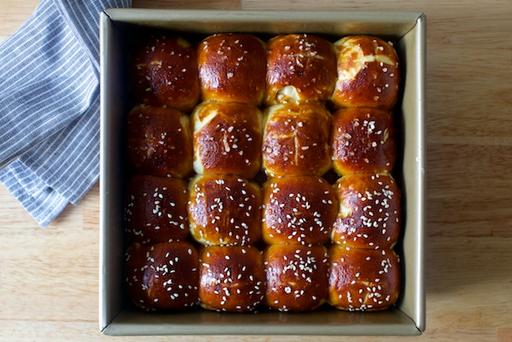 Pretzel Parker House Rolls
Pretzel Parker House Rolls
From: smittenkitchen.com
Makes 16 small rolls.
Rolls
3/4 cup plus 2 tablespoons milk
1 1/2 tablespoons granulated sugar
1 1/4 teaspoons (half a 1/4-ounce or 7-gram packet) active dry yeast
3 tablespoons unsalted butter, melted, plus extra to coat bowl
2 cups flour, either all-purpose or bread flour, or a mix thereof, plus extra for dusting
1 teaspoon fine sea or table salt
To finish
1/2 cup water
1 1/2 teaspoons baking soda or food-grade lye (see Notes below)
1 egg, beaten with 1 teaspoon water
Pretzel salt, coarse salt or sesame seeds
Make dough: Warm milk and sugar together until they’re about 105 to
110°F (41 to 44°C) in the bottom of a large mixing bowl. If you don’t
have a thermometer, the correct temperature is when you can dip your
finger into the liquid without noticing any temperature change (i.e.
not warmer or cooler than your finger). Add yeast to milk-sugar mixture
and let stand for 5 to 7 minutes. It should dissolve and become
slightly foamy.
Stir in butter, then 3/4 of flour, the salt, then remaining flour.
Using spoon (for manual mixing) or dough hook (of a stand mixer), mix
the dough until it forms a slightly sticky dough that balls together.
If making by hand, turn out onto a floured counter and knead until
smooth and elastic, about 10 minutes. If using a machine, let the dough
hook do the work, running it for 5 minutes on low. If, at the end of
the kneading process, the dough still feels quite sticky (a little
sticky is good; more tips here), add 1 more tablespoon flour.
First rise: With kneaded dough on counter, butter or oil your mixing
bowl. Return dough to bowl, cover with plastic wrap and place in a
draft-free warmish spot for 1 hour, or until doubled in bulk.
Second rise: Butter an 8×8-inch square or equivalent size baking pan
(such as a 9-inch round cake pan or deep-dish pie plate). Flour your
counter and let dough fall out onto it. I like to take advantage of the
round shape left by the bowl to divide my dough into even-enough
wedges, like slices of a pie. Divide into 16 pieces. Form each into a
round. Arrange seam side-down in prepared pan, with an even amount of
space between rolls. Cover loosely with plastic wrap and let rise for
another hour. About 10 minutes before the hour is up, begin the next
step to heat the oven and prep pretzel wash.
Pretzel it! Heat oven to 375°F (190°C). If using the baking soda
option, bring your water to a boil and slowly stir in baking soda — it
will foam up. If using the food-grade lye option, do not heat your
water, just stir the lye into the water in a sink, wearing gloves (see
more precautions in Notes below).
Thoroughly brush tops and creases between rolls (as best as your brush
can get in) with the lye or soda pretzel wash. Rinse brush and beat
your egg with 1 teaspoon water. Brush the rolls a second time, this
time with the egg wash. Sprinkle rolls with either sesame seeds or
coarse salt. Use a sharp paring knife to make +-sign slashes in the top
of each roll; you want to cut at least 1/2-inch down (I always make my
cuts too shallow and they get lost when baked).
Bake: Bake rolls for 20 to 25 minutes, until a lovely brown on top. Let
cool in pan on rack. Salt-topped rolls are best on the first day.
Sesame-topped rolls keep better, and can easily be frozen and stashed
for future bread emergencies urgencies.
Notes:
Doubling
this recipe: This can be doubled in a 9×13-inch pan, to yield 24 (in
4×6 rows), 28 (7×4 rows) or 35 (7×5) rows. For the 24-roll yield, allow
5 extra minutes of baking time.
Soda vs. Lye Wash: The baking soda wash is more pale than the lye
option, but you’d only know this if you were comparing it side by side
to the lye wash. The pretzel flavor is still there, which is what
really matters.
Glossiness: That said, I had really wanted these rolls to be glossier
and in the next batch, followed the soda/lye washes with an egg wash.
You can absolutely skip this if you don’t want the extra step (or don’t
eat eggs), but it does add a nice sheen.
Salt vs. Sesame Seeds: Finally, I sprinkled half of each batch with
coarse salt and the other half with sesame seeds. It’s best to eat the
salted ones right away; the salt will eventually dissolve when
leftovers are wrapped, even in the freezer.
Food-Grade Lye: Lye is a strong akali which is highly soluble in water.
Food-grade lye is FDA approved in the U.S. To use it, it’s best to wear
latex gloves (though even dishwashing ones work), an apron and goggles
(swim or onion goggles work too) for extra protection. Mix the lye in a
glass or plastic bowl, as lye can corrode reactive metals.


